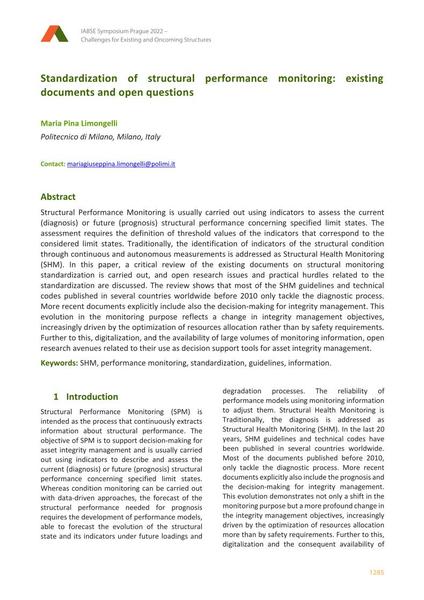Standardization of structural performance monitoring: existing documents and open questions

|
|
|||||||||||
Bibliographic Details
| Author(s): |
Maria Pina Limongelli
(Politecnico di Milano, Milano, Italy)
|
||||
|---|---|---|---|---|---|
| Medium: | conference paper | ||||
| Language(s): | English | ||||
| Conference: | IABSE Symposium: Challenges for Existing and Oncoming Structures, Prague, Czech Republic, 25-27 May 2022 | ||||
| Published in: | IABSE Symposium Prague 2022 | ||||
|
|||||
| Page(s): | 1285-1291 | ||||
| Total no. of pages: | 7 | ||||
| DOI: | 10.2749/prague.2022.1285 | ||||
| Abstract: |
Structural Performance Monitoring is usually carried out using indicators to assess the current (diagnosis) or future (prognosis) structural performance concerning specified limit states. The assessment requires the definition of threshold values of the indicators that correspond to the considered limit states. Traditionally, the identification of indicators of the structural condition through continuous and autonomous measurements is addressed as Structural Health Monitoring (SHM). In this paper, a critical review of the existing documents on structural monitoring standardization is carried out, and open research issues and practical hurdles related to the standardization are discussed. The review shows that most of the SHM guidelines and technical codes published in several countries worldwide before 2010 only tackle the diagnostic process. More recent documents explicitly include also the decision-making for integrity management. This evolution in the monitoring purpose reflects a change in integrity management objectives, increasingly driven by the optimization of resources allocation rather than by safety requirements. Further to this, digitalization, and the availability of large volumes of monitoring information, open research avenues related to their use as decision support tools for asset integrity management. |
||||
| Keywords: |
guidelines standardization SHM performance monitoring information
|
||||
| Copyright: | © 2022 International Association for Bridge and Structural Engineering (IABSE) | ||||
| License: | This creative work is copyrighted material and may not be used without explicit approval by the author and/or copyright owner. |
||||
